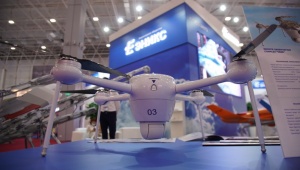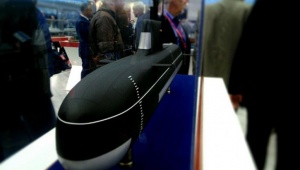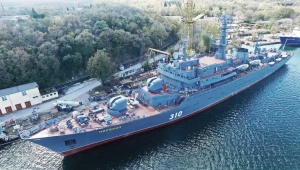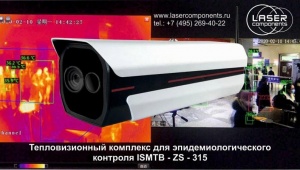Robotic system Paladin
The robot is designed by the all-Russian research institute Signal (division of High Precision Systems holding in Rostec State Corporation). Reportedly, the system is based on BMP-3 infantry fighting vehicle, other details has not been disclosed so far.
In 2015, Signal presented another project based on BMP-3, the robotic system Udar armed with the combat module operating the 30-mm gun, the 7.62-mm machinegun and the Kornet antitank guided missiles launchers. The similar module is mounted on the advanced combat vehicles based on the platforms Bumerang and Kurganets.
Air defense system S-350 Vityaz
S-350 systems are designed to replace obsolete S-300P and S-300PS ones. Vityaz features the round search and engagement mode, in contrast to the sector-type capability that S-300 had. In addition, the new air defense system features considerably increased number of concurrent engagements and aimed missiles.
The system uses 9M100 missiles capable to hit any aerodynamic or ballistic target at the distance of about 120 km moving at the speed of up to 4.8 km/sec, and 9M96 missiles to intercept low-altitude targets at the distance of up to 15 km like cruise missiles, unmanned aerial vehicles and loitering combat units moving at the speed of up to 1 km/sec.
It was reported in April that the new systems had successfully passed the state trials.
Wheel-based middle-size recovery vehicle REM-KS
At the Army-2019 forum, Project Technika will present the wheel-based middle-size recovery vehicle REM-KS. It is designed to assist drivers in technical maintenance, current repair and evacuation of the special-purpose wheeled chassis BAZ (carrying capacity up to 18 tons), as well as weapons and military hardware based on this chassis with the full weight up to 38 tons.
REM-KS is mounted on the four-axis haul truck BAZ-6910 Voschina made by Bryansk Automobile Plant. It carries a working module with repair tools and a boom with load moment 25.2 ton-meter. The onboard repair set includes welding and soldering stations, chargers, diagnostic facilities, grinding equipment, painting and carpenter tools, tire repair equipment and other facilities.
The vehicle may transport wrecked equipment by either semi-loading or towing methods. The crew consists of three men. The vehicle weights almost 30 tons and is 12.5 meters long.
Russian military tested REM-KS in 2016. Based upon the trials, the vehicle was commissioned. It is produced in two versions that differ by cabin design; at the Army-2019 forum, the manufacturer will show REM-KS1 version with unarmored cabin.
Autonomous engine starting system
Another novelty helping to handle tracked or wheeled vehicles in extreme conditions will be the autonomous engine starting system (AESS) designed by TEEMP. It is capable to warm up and ensure starting of combustion engines at the ambient temperature of down to -50˚C.
AESS is intended to start engines of armored vehicles and military wheeled trucks instead of the floating storage batteries, autonomous powerplants, or engine starters in wintertime by a set of wires.
The system provides pre-starting warmup and external electric startup of piston and turbo-piston engines of vehicles with onboard voltage of 24/48V. Optionally, AESS is compatible with 12V networks. Another option is startup of 24/48V gas turbines. The system provides at least five startups one after another, ensuring main engine starting procedures. Overhaul life is 100,000 cycles.
The supercapacitor-based devices have already drawn the interest of the Russian security agencies. For instance, in 2019, TEEMP kicked off supplies of the CC-12V200F-0 supercapacitor starting systems for UAZ Patriot rovers used by the Ministry of Interior. This solution was needed due to the large amount of additional equipment mounted on the police vehicles, and their wide use at low temperatures, which hinders the engine startup after long outdoor halts.
Military boom truck KMV-20K
Klintsovsky Truck Crane Plant (KAZ) will demonstrate the KMV-20K military boom truck already commissioned in the Russian army. Based on the flat-bodied KAMAZ-63501 four-axial chassis, it is designed for cargo handling operations, including hazardous ones, using additional equipment: rotator, pipe grab, hydraulic shear, pincer grab, borer, windlass, hook grapple, forklift hoist, and working platform.
Load moment is 24.1 ton-meters, max lifting capacity is 7.2 tons, max outreach (12 meters) lifting capacity is 1.8 tons, lifting height is up to 15 meters.
The crane has three option packs:
- with load handling device pivoted to the boom head;
- with hanger cable, cargo hook and windlass;
- with rotator for various grabs, hydraulic shear, borer, working platform, and other tools.
Another product of KAZ, the KMU-10K manipulator crane will be presented on the AT-1 special-purpose truck. The vehicle is designed for the Railway Troops. Equipped with KMU-10K, the AT-1 truck is based on the 8x8 KAMAZ-6560 chassis. The vehicle is a part of the PM-TOR mobile maintenance workshop.
Modernized air defense system Pantsyr-SM
The upgraded Pantsyr is based on the Tornado wheeled platform. Its distinctive feature is the multifunctional sighting station with phased-array antenna. This helps the system to detect targets at the range up to 75 km. Aiming range of Pantsyr-SM will be increased up to 40 km, which is twice as long as that of Pantsyr-S1 system.
Allegedly, the new system will use missiles with doubled max speed (3,000 mps against 1,300 mps of the Pantsyr-S1’s missile, 57E6E).
State trials of Pantsyr-SM may be prolonged up to 2021.
Self-propelled artillery system 2S42 Lotos
Project Lotos has become a development and a substitute for Project Zauralets that provided for designing of a new self-propelled artillery system for Airborne Troops. Basic weapon of the Lotos system is the 120-mm gun, while the shell has undergone considerable modernization which resulted in the destructive power comparable to the 152-mm ordnance.
Combat load of the Lotos system has grown twice comparing to its predecessor, 2S9 Nona, from 20 up to almost 40 shells.
Assembly of the Lotos prototype sample began in October 2018. The artillery system is expected to pass state trials this year.
Heavy attack UAV Hunter
Sukhoi began designing of Hunter under the defense contract in 2011. First model of the UAV for ground trials was made in 2014.
Reportedly, Hunter is designed under stealth technology and ‘flying wing’ aerodynamic layout (no tail fins), takeoff weight is 20 tons. Allegedly, the vehicle is powered by one jet engine and capable to accelerate up to 1,000 kph.
In November 2018, the Hunter prototype took the first run along the runway of Novosibirsk Aircraft Plant and reached the speed of 200 kph. Maiden flight of the UAV is scheduled in this summer. According to the steering committee, Hunter will be demonstrated at the outdoor section of the Patriot Congress & Expo Center.
Arctic-type container
Produced by Project Technika corporation, the Arctic-type container is designed as a basis for mobile and stationary modules of technical/communications/logistic/medical/other use operated in the Far North regions.
In contrast to the standard container, it has additionally winterized walls and ceiling in the inhabited section. Thermal resistivity of the inner walls is increased by 70%, which allows for reducing power consumption to maintain temperature in the inhabited section by 35%; there are no thermal bypasses; non-combustible materials are used for heat insulation and interior finishing.
The basic version features the power supply system with safety control devices, the workspace illumination system, the input niche with a set of cables for external network connections, the loading/unloading devices, the air filtration facility, the fuel-type heating system, the electric-type heating system, the underfloor heating system, the drop ramp for using the container installed on the chassis, and the firefighting equipment set.
The Arctic-type container is easily transportable; all its components fit into the standard 1C size (20-foot container). This allows for transportation on the standard railway container cars or containerships.
The container designed by Project Technika has already passed trials in the extreme conditions of the Far North and the Arctic.
Demonstration of marine water/fuel treatment equipment
Experts of Vineta Ltd (Leningrad Region, Russia) will show the forum participants the operation of seawater desalting plants as a part of the water treatment/diesel fuel polymeric purification system.
Visitors of the forum will have an opportunity to watch the process of getting drinking water out of the seawater with the salt content of 35,000 mg/l. According to Alexander Kalinin, head designer of Project 12700 minesweepers, these distillers will replace the American ones previously mounted on the Alexandrite-class ships.
Another component of the water treatment system that is going to be demonstrated is the portable filtering plant capable to obtain over 180 liters of clean drinking water out of any natural fresh water. It ensures 99.999% water purification from bacteria and viruses.
Further, the Vineta experts will present the process of diesel fuel separation by polymeric filtering elements used in the family of static separation units. The equipment was designed and is manufactured under the import substitution program.
Luneberg antennas: discussion of the future
The Army forum participants not only present the ready-made items but also discuss scientific expertise required for designing of the cutting-edge products for the Russian Armed Forces. During the business program, the researchers and the military will jointly consider the prospects for a broadband multi-beam antenna based on the Luneberg lens. Dmitry Denisov, an expert in high-frequency modeling at KAE Expert (division of PLM Ural Group) and the chairperson of the IT Systems Department at the Ural Technical University of Communication and Information Technology, will report on the results of computations regarding antenna and diffraction characteristics of such lens.
The presentation will be held under the panel discussion named "Advanced Radio Navigation & State Aircraft Landing Systems Based on Global Navigation Satellite Systems and Augmentations".
The lens computations were made in ANSYS HFSS software package, an interscience toolkit designed for computations of the multiphysics processes, for example, integrated modeling of the physical processes in terms of one or another product.
Comparing to common antennas, the Luneberg lens has a number of advantages. It is distinguished by excellent aerodynamics and can be used in wide band of frequencies. Such antenna may be mounted on any facilities. Production of the lens is possible using additive technologies (3D printing), this process can be computed in ANSYS software package, as well.
The fifth Army International Military & Technical Forum will take place in June 25-30 at Patriot Congress & Expo Center, at Alabino Range and Kubinka Airbase. The forum will be open for experts in June 26-27, and for mass visitors in June 28-30.
Mil.Press publishes the news about the exhibition’s display in the section Army Forum.


































